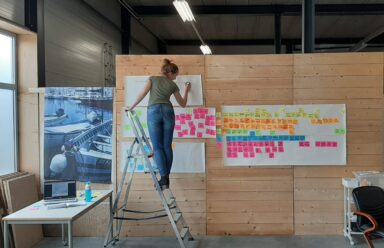How story structure can help you build better stories
Deze blogpost is eerder gepubliceerd op Medium op het kanaal van Mark Geljon en is in het Engels gepubliceerd.
Storytelling: the buzz
There is a big need for structure and connection in today’s information society. The amounts of data and information we have to process is so high, we tend to be overwhelmed and filter the information at the gate. We leave possible valuable knowledge outside, focusing more and more on what we already know.
Only in stories you can engage and learn at the same time. Stories are highly effective for more high end communication goals such as engagement, activation and inspiration. Since marketers know that’s where the magic happens, everyone is searching for that holy grail: optimal effective stories.
Furthermore, digital media make it extremely easy to create visually appealing story content. This means a lot of content is produced in the moment, lowering the quality and making it even more important to create effective stories to stand out in the crowd!
Creating good stories is a craft (one you need to get good at)
Complex stories require good structure. The attention span and time spent on consuming the information is getting lower and lower. A story should be spot-on in order to get the point across and inspire the audience in the areas you want to engage with them.

Lots of today’s stories are high on design but low on story quality. Impressive visual content that baffles you and leaves you with no clue as to it’s message. Bad stories delivered in a bad way. Ineffective stories cause confusion and basically are timewasters.
Story architecture can help in building good stories by offering methods for analysing, organising and structuring story elements into compelling stories.
| SPOILER: there is an app for that! (see below)
Storyline patterns provide direction for structuring a story.
At GriDD we created an app to assist in selecting the right story structure to optimize stories towards goals and audiences. Based on our app, these are the three most used storylines:
- Heroes journey
The heroes journey is used to tell your, or someone else’s, personal journey to explain how the main character became a hero. This storyline uses a chronological timeline. In the beginning the main character is a normal person. At some point the situation changes and the main character should do something to save the situation (the challenge). His development in overcoming the challenge to come to a resolution, he develops and becomes “a hero”. After this he returns and the situation turns back to “normal” again.
This storyline is useful if you want to inspire or activate people to be a hero too. Your story can show them that it is possible to be a hero, even when you are not born as a hero. It’s also a good storyline to explain how you got the guts to undertake certain actions.
- Mountain story
In this storyline, a linear approach is used to build op the reasoning towards a clear conclusion. After an introduction, a sequence of challenges and sub conclusions lead to a general conclusion. After this a wrap-up is provided with a clear moral of the story and actionable next steps.
This storyline is useful if you want to present a result based on different insights and actions. Every decision is a step closer to the conclusion
- Nested loops
The stories within a nested loop storyline have some overlap and are logical consequences of each other. So, the nested loops storyline contains stories within another story, but these are not stand-alone stories.
Using the nested loops storyline you can explain why you did or stated something. Several similar experiences support your main point. Every experience is a new story.
Starting with a clear focus on goal and audience helps to select the best storyline.
Apart from your goal and audience, first you have to decide what type of story you since it influences the decision for a storyline structure. Are you pitching an idea, preparing a keynote talk for a conference or giving a formal presentation for the board of directors? Some storylines work better for one type of story than for another.
- Story types to choose from in our app Bizz Story:
Formal presentation, Keynote talk, Pitching your idea, Out of the box, Leadership story, Teaching
In our experience, it is very hard to step back and decide on the goal, audience and context of your story. These decisions are crucial to make stories effective. It matters a great deal if you want to activate, motivate, etc. so decide carefully.
- Goals to choose from in our app Bizz Story:
Enjoy, Inspire, Motivate, Activate, Explain, Inform, Educate, Convince, Trust
A clear image of the audience type helps to further fine-tune the story and is essential input when considering a storyline pattern. A critical audience (typically) requires more traditional structure, whereas an eager audience can be surprised with more emotional driven structures.
- Audiences to choose from in our app Bizz Story:
Ambitious, Creative, Difficult, Emotional, High End, Linear thinkers, Open minded, Practical
We are working hard to extend our models to include more parameters into the equation, and justify them with data. Not with the intend to create a rigid framework, but with the intent to offer more specific guidance for story makers (which basically is every professional nowadays).
So: start today to craft better stories using storylines.
I hope I have provided you some food for thought about taking story architecture seriously in your daily work. If my ideas resonate with you and you would like to learn more (including examples per storyline pattern and instructions on how to apply them) download our app Bizz Story from the App store or Google Play Store.
 GriDD
GriDD 


